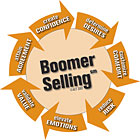When Baby Boomers buy any product, we instinctively believe it will perform its designed function. If we buy a replacement comfort system, we expect it will automatically provide the right level of warm and cool air throughout our homes. We assume our physical requirements will be met. What our subconscious minds are desperately seeking is people and products that will satisfy our emotional needs.
EMOTIONS
Unlike hot and cold air, emotional benefits are never completely obvious to the buyer or sellers.Emotions are the prime motivator of all human actions. Emotions create compelling psychological needs that crave immediate satisfaction and make up an essential part of all human decision making. Emotions, like aromas, are pleasant or unpleasant, positive or negative. Positive emotions create excitement, commitment, and desire for action. Positive emotions include:

•Pride:Up to 40 percent of Boomer buying decisions are ego driven.
•Prestige:How much does a Mercedes-Benz hood ornament cost to make? How much does it add to the value of the car?
•Gain:Boomers are extremely emotional about making, saving and losing money.
•Happiness:The unconscious goal of every Boomer purchase is to increase happiness.
•Comfort:If we’re not emotionally comfortable, it’s hard to be physically comfortable.
•Desire:We buy what we desire, not what we need.
Desire is the primary emotion that controls what Boomers buy, who we buy it from and how much money we’ll spend. When we buy a replacement comfort system, we usually start out to satisfy the same basic need; “Get me cool again, now!” Because we’re making an infrequent, probably unplanned, complex purchase, we have no idea of all the ways you can improve our physically and emotional well being. When you improve both our physical and emotional comfort, your hot and cold air focused competition doesn’t stand a chance.
THE ANSWER'S IN THE QUESTION
Questions are more emotionally powerful than statements. Empathy is the ability to recognize and understand the emotions of others. Questions unlock the door to empathy. Asking the right question the right way at the right time is the key to helping us both discover my unconscious desires.“I keep six honest serving men
(They taught me all I knew);
Their names are What and Why and When
And How and Where and Who.”
- Rudyard Kipling
After asking a building-block question like “Does anyone in your family suffer from airborne allergens or asthma?” don’t rush to the next question on your list. Pause a second or two, then ask follow-up questions that arise spontaneously as we talk, such as:
• “What time of year are your grandson’s allergies to pollen the worst?
• “Do his allergies affect how he sleeps?”
• “Does his restless sleep affect his school work or study habits?”
Asking intelligent, unplanned questions turn an interview with a salesperson into a conversation with a friend. The more comfortable we are with you, the easier it is to reveal our feelings, fears, and desires. The smarter the questions you ask, the easier it is for us to discover it’s not about buying a box that blows cold air, it’s about protecting the comfort, health, and welfare of our loved ones.
DESIRES: FROM VAPOR TO CONCRETE
My talent lies in my ability to ask very simple,yet very powerful, questions like, “What if …?”
- Albert Einstein
When you ask us to prioritize our problems, an amazing thing happens. The wants and needs hiding out in our subconscious mind are suddenly transformed into conscious thoughts. “If we could significantly reduce the airborne pollen that’s affecting your grandson’s allergies, would that be a high, medium, or low priority?” High priorities are conscious desires. Medium priorities are wants that could become desires with more information.
THE PHYSICAL EFFECTS OF DESIRE
Emotions are accompanied by physical changes. The word “emotion” comes from two Latin words: “ex” for out or outward and “moto” for movement or motion. Emotions are created by neurochemicals like dopamine, noradrenalin, and serotonin. Among other things, these self-manufactured drugs speed up the brain’s activity level, which creates changes in body movement.Positive emotions can cause involuntary physical expressions like heavier breathing, increased eye contact, relaxed facial expressions, larger pupil size, etc. If you’ve watched Texas Hold-Em on television, you’ve noticed many of the best players hid their faces with sunglasses and hats to keep from giving away their hands with involuntary signals. Even professional poker players can’t control their “outward motion.”
Instead of trying to focus on every change in body language (which can severely limit your ability to listen) look for subtle changes in mood and demeanor: speaking faster, more excitement in their voice, interrupting the conversation to ask questions about price, warranties or availability. Don’t get hung up on old sales rules like “crossing arms is a defensive gesture.” For some Boomers, crossed arms simply reduces back pain.
DESIRE TRUMPS PRICE
Desire is the engine that drives Boomer HVAC replacement comfort system sales. When money is tight, Boomers will spend less in other areas in order to buy the things we desire most. When desire is high, Boomers will find the money to buy.TAKEAWAY POINTS
In conclusion, remember and utilize the following points when selling to Baby Boomers:• Desire is a strong want fueled by emotions.
• The most important motivator in buying isn’t facts, it’s feelings.
• The faster and deeper your emotional connection with the buyer, the quicker and more likely the sale.
• Emotional priorities are always more important than price.
• We don’t buy what we need, we buy what we desire.
• It’s not so much creating new desires as it is helping us discover the desires we already have.
• It’s not about the problems the home has; it’s about the needs, wants, and desires of the people who live or visit us there.
Publication date:03/24/2008


Report Abusive Comment